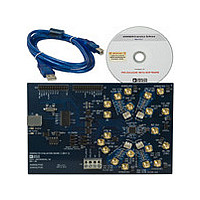AD9959/PCB Analog Devices Inc, AD9959/PCB Datasheet - Page 14

AD9959/PCB
Manufacturer Part Number
AD9959/PCB
Description
Manufacturer
Analog Devices Inc
Datasheet
1.AD9959PCB.pdf
(28 pages)
Specifications of AD9959/PCB
Lead Free Status / RoHS Status
Not Compliant
AD9959/PCB
The Enable ASF box also represents the starting point of the
linear amplitude sweep and the first level in amplitude
modulation (ASK). Note that when performing linear
amplitude sweeps, the Enable ASF box must be left unchecked.
When using the RU/RD feature, the Enable Auto ASF box must
be checked. Once the Enable Auto ASF box has been checked,
the Amplitude Ramp Rate, Amplitude Step Adjust, and the
Load ARR @ I/O Update options are available (see Figure 25).
Use the Amplitude Ramp Rate box to set the Amplitude Ramp
Rate (ARR) time. This time (entered in µs) can range from a
minimum value of:
to a maximum value of:
This implies that if the system clock is 500 MHz, the ARR value
can range from 8 ns (minimum) to 2.040 µs (maximum). If the
value entered exceeds the maximum time, then a pop-up
window (Figure 26) alerts the user that the value entered will be
changed to the appropriate maximum value.
In the Amplitude Step Adjust box, select the amplitude scale
factor step size. The default setting of this box is 1, indicating
that step size will be 1 LSB. A selection of 8 means the step size
will be 8 LSB.
Select Load ARR @ I/O Update to load the contents of the
amplitude ramp rate register into the amplitude ramp rate timer
every time an I/O_UPDATE is sent to the device.
2. Profile Registers
The AD9959 features up to 16 programmable registers per
channel as shown in Figure 23. Due to certain channel
constraints, however, there are limitations on how the Profile
Registers can be used in some configurations as described in the
Channel Constraint Guidelines section of the AD9959 data sheet.
(
( (
SYNC
SYNC
1
CLK
1
CLK
)
×
)
1
×
2
(
8
bits
Figure 25.
Figure 26.
of
output
ramp
rate
resolution
)
−
1
)
Rev. 0 | Page 14 of 28
Use the Profile Registers to enter the information needed for
modulation (FSK, PSK, or ASK) and linear sweep modes of
operation. Upon default, the Profile Registers are configured for
frequency inputs, but these registers can be changed to intake
phase or amplitude information by selecting the desired
modulation type in the Modulation Output Type box in the
Channel Control window. Figure 27 shows how the Profile
Registers appear when phase modulation (PSK) is selected.
When the channel is in the modulation or linear sweep mode of
operation, input the starting frequency in the Frequency 00
box, starting phase in the Phase Offset box, and the starting
amplitude in the Enable ASF box. In modulation mode, use the
Profile Registers to input frequency, phase, or amplitude
information for the level of modulation selected. For instance, if
4-level frequency modulation is selected, input the starting
frequency in the Frequency 00 box, second frequency in the
Frequency 01 box, third frequency in the Frequency 02 box,
and fourth frequency in the Frequency 03 box. An example of
using the Profile Registers for 2-level frequency modulation is
shown in Figure 28. In this configuration, the frequency starts
at 10 MHz and ramps up to 50 MHz.
Figure 27.










